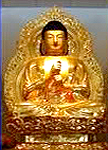Birojanabul | Dharmakaya Buddha ~ Birojanabul is sometimes referred to as the Cosmic Buddha spreading the light of truth in all directions. Birojanabul is the embodiment of the Universal law of interdependence. Mudra (hand position): The right hand holding the finger of the left hand symbolizes five worldly elements in unity with spirit. This hand position is often called the Knowledge fist, dispelling the darkness of the deluded mind.
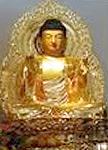 Nosanabul | Sambhogakaya Buddha ~ Nosanabul represents the Buddha body of bliss and fruit of practice as well as the communion of the absolute and relative realms. Nosanabul is considered the Buddha of path of spiritual maturity/ripening. Mudra (hand position): Both hands raised, palms outward represents teaching, protection and a compassionate gesture dispelling fear.
Nosanabul | Sambhogakaya Buddha ~ Nosanabul represents the Buddha body of bliss and fruit of practice as well as the communion of the absolute and relative realms. Nosanabul is considered the Buddha of path of spiritual maturity/ripening. Mudra (hand position): Both hands raised, palms outward represents teaching, protection and a compassionate gesture dispelling fear.
 Sogamonibul | Nirmanakaya Buddha ~ Sogamonibul, known as Shakyamuni Buddha, represents the historical Prince Siddhartha Gautama, born in Nepal over 2,500 years ago. The Prince renounced his royal life and began a personal quest to discover his true self beyond suffering. After many trials and while sitting in meditation he attained enlightenment and began teaching others. When asked if he was a God, Sogamonibul simply replied that he was, AWAKE. Mudra (hand position): left hand in meditation position, right hand touching the earth in confirmation of ultimate reality of awakening.
Sogamonibul | Nirmanakaya Buddha ~ Sogamonibul, known as Shakyamuni Buddha, represents the historical Prince Siddhartha Gautama, born in Nepal over 2,500 years ago. The Prince renounced his royal life and began a personal quest to discover his true self beyond suffering. After many trials and while sitting in meditation he attained enlightenment and began teaching others. When asked if he was a God, Sogamonibul simply replied that he was, AWAKE. Mudra (hand position): left hand in meditation position, right hand touching the earth in confirmation of ultimate reality of awakening.
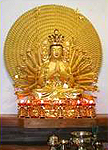 Kwanseum Bosal | Bodhisattva of the Perfection of Wisdom and Compassion ~ Kwanseum Bosal, or Avalokiteshvara, is widely recognized as Kuan-Yin. This Bodhisatvva is often depicted in gender neutral or female forms. This statuary is called, Thousand Hands and Eyes. Mudra (hand position): A thousand eyes watch over the suffering of the world with equanimity , a thousand hands reach out in self-giving love to ease and eliminate that same suffering.
Kwanseum Bosal | Bodhisattva of the Perfection of Wisdom and Compassion ~ Kwanseum Bosal, or Avalokiteshvara, is widely recognized as Kuan-Yin. This Bodhisatvva is often depicted in gender neutral or female forms. This statuary is called, Thousand Hands and Eyes. Mudra (hand position): A thousand eyes watch over the suffering of the world with equanimity , a thousand hands reach out in self-giving love to ease and eliminate that same suffering.
 Cheon Beop Myeong Wang Seong Kwanseum Bosal ~ This figure represents the Cosmic Matriarch of the Perfection of Wisdom and Compassion — the “Mother” of the cosmic hosts of Bodhisattvas. The left hand resting on the chest symbolizes dharma nutriment that is provided to all who suffer. The right hand holds the lotus flower, which blossoms in mud ponds, but it is not tainted and keeps its purity always. It is like Buddha and Bodhisattvas, who lived in the world but remained pure.
Cheon Beop Myeong Wang Seong Kwanseum Bosal ~ This figure represents the Cosmic Matriarch of the Perfection of Wisdom and Compassion — the “Mother” of the cosmic hosts of Bodhisattvas. The left hand resting on the chest symbolizes dharma nutriment that is provided to all who suffer. The right hand holds the lotus flower, which blossoms in mud ponds, but it is not tainted and keeps its purity always. It is like Buddha and Bodhisattvas, who lived in the world but remained pure.
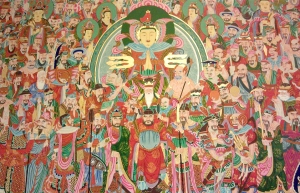 Shin Jung Cheong | Guardians and Protectors In the main hall there is Shin Jung Cheong mural, which serves to depict imagery of the Buddhist cosmic view. The figures represented in this mural derive from the Hwa Eom Gyeong (Avatamsaka Sutra). These figures are the guardians and protectors of both the human and cosmic realms.
Shin Jung Cheong | Guardians and Protectors In the main hall there is Shin Jung Cheong mural, which serves to depict imagery of the Buddhist cosmic view. The figures represented in this mural derive from the Hwa Eom Gyeong (Avatamsaka Sutra). These figures are the guardians and protectors of both the human and cosmic realms.
Sogamonibul Pagoda | Seokgatap ~ The origin of the pagoda can be traced to the stupa, a 3rd century a dome shaped monument used as a commemorative monument associated with storing sacred relics, or sarira (Korean). This pagoda is inscribed with the mantra Om Mani Padme Hum. Walking meditation while chanting the mantra 108 times, is performed at this site – circumabulating the pagoda in a clockwise direction.
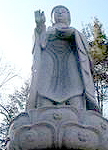 Yaksayoraebul | Medicine Buddha ~ The literal meaning of Yaksayeoraebul is Teacher of Buddha-Nature medicine. This represents each person’s capacity for strengthening and healing mind and body by eliminating ignorance and waking up to one’s true self — unaffected by ill health and dis-ease. Mudra (hand position): The raised hand is in a gesture of protection while the other hand holds a medicine jar representing healing through practice.
Yaksayoraebul | Medicine Buddha ~ The literal meaning of Yaksayeoraebul is Teacher of Buddha-Nature medicine. This represents each person’s capacity for strengthening and healing mind and body by eliminating ignorance and waking up to one’s true self — unaffected by ill health and dis-ease. Mudra (hand position): The raised hand is in a gesture of protection while the other hand holds a medicine jar representing healing through practice.
 Mirukbul | Future Buddha ~ Known in Korean as Mirukbul and also called Maitreya, this is the Future Buddha. Mirukbul has yet to be reborn into the world and waits patiently with supreme wisdom and compassion until that time of need. Future Buddha is considered a Bodhisattva, refusing entry into Nirvana until all beings are freed from the cycle of birth and death. Mudra (hand position): This gesture is one of reflection, contemplation and teaching as signified by the hand forming a circle with the thumb and index finger, symbolizing completeness and perfection, having no beginning or end.
Mirukbul | Future Buddha ~ Known in Korean as Mirukbul and also called Maitreya, this is the Future Buddha. Mirukbul has yet to be reborn into the world and waits patiently with supreme wisdom and compassion until that time of need. Future Buddha is considered a Bodhisattva, refusing entry into Nirvana until all beings are freed from the cycle of birth and death. Mudra (hand position): This gesture is one of reflection, contemplation and teaching as signified by the hand forming a circle with the thumb and index finger, symbolizing completeness and perfection, having no beginning or end.

